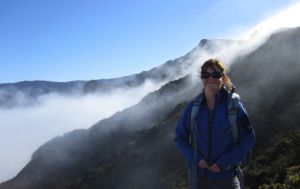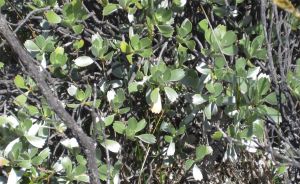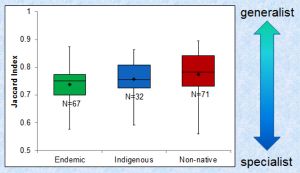Predicting the effects of climate change: ecosystem drivers in the tropical subalpine shrubland

Tropical mountains are thought to contain many habitat specialist species adapted to harsh environmental conditions. These species may be especially vulnerable to rapidly shifting climates (Fig. 1). For this project, we used a novel species co-occurrence-based measure, based on Jaccard’s dissimilarity index, to assess habitat specialization for 170 species from > 1000 plots on three of the Hawaiian Islands. Many specialists that were identified had small geographical ranges and occurred in climatically-challenging, high-elevation sites (e.g., native shrubs Geranium cuneatum (Fig. 2) and Dubautia spp., and native sedges). The degree of specialization of plant species differed by biogeographic origin (endemic, indigenous, non-native). Endemic Hawaiian plant species (n = 67) were more abundant at the specialist end and in the middle of the continuum. Indigenous species (n = 32) were less specialized, and non-native plants (n = 71) dominated the generalist end (Fig. 3). Ongoing analyses are testing whether specialization correlates with specific functional traits (e.g., dispersal mechanism, leaf size). Co-occurrence analysis appears to be a useful technique for identifying habitat specialization.
Results Dissemination
Oral and poster presentations on these preliminary results of using this novel habitat specialization characterization method were given locally and internationally during the past two years, including winning the best graduate student poster award in August 2015 at the Hawai‘i Conservation Conference in Hilo, Hawai‘i . Continued research on this topic to complete Ainsworth’s PhD will focus on characterizing plant community differences in habitat specialization across the distinct Hawaiian treeline (wet/cloud forest versus subalpine shrubland).
PROJECT DETAILS
FUNDED:
FY2013
PI:
Don Drake
Professor of Botany, UH Mānoa
Co-PI:
Alison Ainsworth
Department of Botany, UH Mānoa



